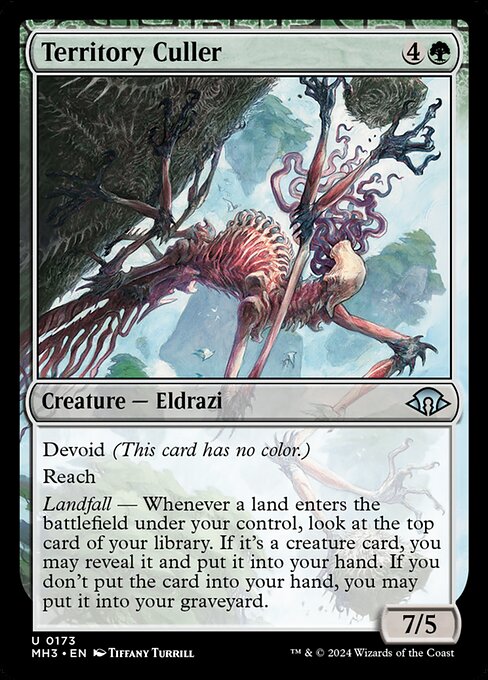
Image courtesy of Scryfall.com
Why constraint inspires better deckbuilding
Constraint is not a prison for MTG players; it’s a compass. When you lean into a card’s built‑in limits, you’re nudged toward clever lines of play, tighter resource management, and a flow of ideas you might not uncover otherwise 🧙🔥. Territory Culler, a green‑leaning Eldrazi from Modern Horizons 3, embodies this lesson in a single, sweeping design: a 7/5 creature with Reach, Devoid, and a landfall trigger that asks you to measure risk and reward every time a land enters the battlefield. The result isn’t just a big body on the board—it's a blueprint for constraint‑driven deckbuilding that rewards careful curation over brute force ⚔️.
Territory Culler: a case study in constrained creativity
With a mana cost of 4G, Territory Culler sits at five mana and arrives as a shockingly resilient body: 7 power and 5 toughness, a solid threat that helps anchor green ramp and midrange strategies. Its Devoid ability means the card is colorless on the battlefield, even though its mana cost bears a green identity. That clash between forced colorlessness and a green mana tax is more than flavor—it’s a design nudge toward multi‑path planning. The real party trick, though, is Landfall: every time a land you control enters the battlefield, you look at the top card of your library. If it’s a creature card, you may reveal it and put it into your hand. If you don’t put it into your hand, you may put it into your graveyard.
This is constraint made tangible. You can’t guarantee you’ll draw a creature the moment you drop a land; you can only maximize the odds by shaping your deck around creature density at the top, or by leveraging effects that let you manipulate the top of your library. The card’s wording rewards a disciplined approach: you’ll be weighing the value of grabbing a creature now versus letting a card slip to the graveyard for later synergy. It’s a micro‑mechanic that cascades into deck architecture 🧙♂️🎲.
Designing around constraints: practical takeaways
- Embrace top‑deck manipulation: Since the trigger asks you to inspect the top card, decks that tend to reveal a creature early benefit more from Territory Culler. Scry, peek, or predictable shuffle effects become more valuable because they tilt the top card’s fate in your favor 🧙🔥.
- Lean into landfall density: The more often you trigger landfall, the more opportunities you gain to fetch a creature or decide to graveyard a non‑creature card. This makes land ramps and fetch lands feel less like a crutch and more like a cooperative partner to Culler’s ability 💎.
- Balance hand versus graveyard value: If you keep hitting creatures, your hand grows; if not, you’ve built a graveyard engine. Territory Culler can slot into strategies that pivot from instant card advantage to long‑game recursion, a delightful constraint—playing the long game and letting the deck’s architecture decide the pace 🎲.
- Rethink color identity in practice: Devoid makes Culler feel “colorless” on the battlefield, yet its color identity points to green. This opens room for cross‑color splashes or purely green shells, letting you test how constraints behave when you mix color ecosystems without losing the core Landfall dynamic ⚔️.
- Role in a portfolio deck: Culler shines when your deck’s plan depends on hitting lands consistently and extracting value from top cards. It’s not a one‑card powerhouse; it’s a constraint engine that rewards thoughtful sequencing and pairing with other landfall and top‑deck tools 🎨.
Physically, Territory Culler’s presence is reinforced by its art and its place in Modern Horizons 3, a set designed as a draft innovation that experiments with new angles on old mechanics. The creature’s 7/5 stats ensure it doesn’t vanish to a single removal spell, and its reach helps it threaten black and red boards that want to rush past your defense. The card’s rarity is uncommon, and even in foil form it remains budget‑friendly—an accessible target for players testing constraint‑driven builds without breaking the bank 🧙🔥.
Beyond the numbers, there’s a narrative thread tied to the Eldrazi theme. Territory Culler embodies the idea of “territory” as a battleground of mental space and physical land—an apt metaphor for a deckbuilder who negotiates land types, library order, and card draw in a single breath. When you combine this with careful land selection, you create a theater where every land drop becomes a potential plot twist, and every top card a decision point. It’s the magic version of a choose‑your‑own‑adventure, where constraint is the quest and the payoff is a well‑tuned, resilient deck 🧭.
And for players who enjoy the tactile ritual as much as the math, Territory Culler offers a gentle reminder: constraint fuels creativity even in a game as expansive as MTG. The more you lean into the card’s rules and the more you tailor your deck to exploit top‑deck reveals, the more you’ll notice that constraint isn’t a straightjacket—it’s a set of rails that guide you toward elegant, surprising combos and steady board presence. It’s a philosophy that fits neatly with the modern approach to drafting and brewing in MH3 and beyond 🧙♀️💎.
Speaking of on‑the‑go magic, there’s a little real‑world ritual that pairs nicely with these creative bursts. Keeping your play space organized, your tokens in reach, and your deck safe while you travel between games is part of the craft—something a MagSafe Card Holder can help with. The lightweight, glossy‑matte design keeps your essentials together so you can focus on the pivot points Territory Culler prompts, not on rummaging for a spare die or a misplaced card. A small tool for a big hobby, helping you stay in the zone as you chase the next top‑deck reveal 🧙🔥🎨.
Magsafe Card Holder Phone Case Polycarbonate Glossy MatteMore from our network
- https://crypto-acolytes.xyz/blog/post/unlocking-the-psychology-of-spending-in-virtual-currencies/
- https://crypto-acolytes.xyz/blog/post/top-cyberpunk-survival-mods-for-immersive-gameplay/
- https://blog.digital-vault.xyz/blog/post/cultural-influences-behind-cetoddles-design-in-pokemon-games/
- https://blog.digital-vault.xyz/blog/post/binary-motion-of-a-blue-hot-star-unveiled-by-astrometry/
- https://blog.digital-vault.xyz/blog/post/stay-hidden-stay-silent-the-luck-skill-balance-in-mtg/